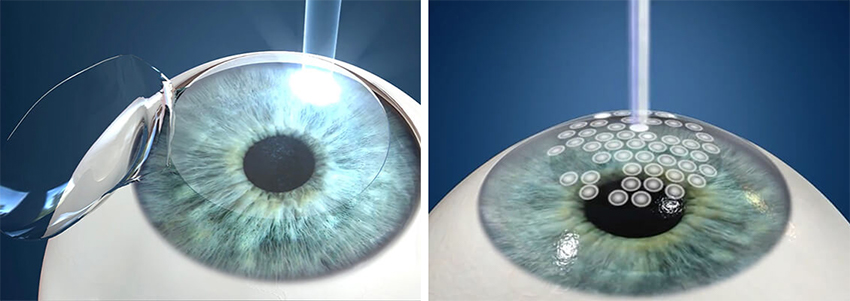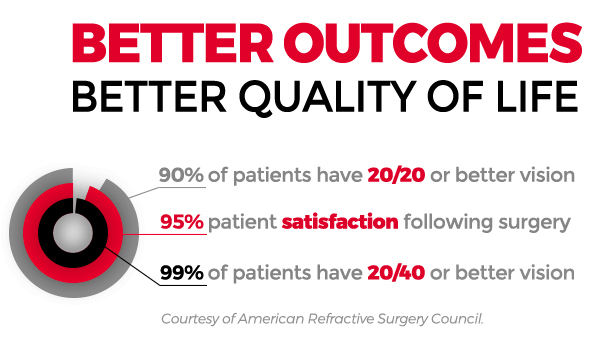LASIK or LASIK eye surgery is a form of vision correction that has been steadily growing in popularity for the past 25 years. Despite it being a well-known procedure, many patients have questions about what LASIK entails, how it works, and the safety of laser technology.
At the New England Eye Center, we understand how difficult it can be to decide if LASIK or laser vision correction is right for you. If you are researching Boston LASIK surgeons we feel that you have come to the right place. We offer LASIK consultations right here in Boston or at one of our many greater Boston satellite locations.
We are happy to educate patients so you can feel informed and empowered in your decision to have LASIK. At New England Eye Center we are not just a LASIK center but we offer a complete spectrum of vision correction services and only suggest the best possible solution to correcting your vision. Keep reading to learn more about LASIK eye surgery.
What is LASIK?
LASIK is an acronym that stands for Laser In-Situ Keratomileusis. The goal of the surgery is to use highly precise laser technology to reshape the cornea and correct vision problems such as nearsightedness, farsightedness, and astigmatism.

How Does LASIK Work?
Nearsightedness, farsightedness, and astigmatism are all caused by variations in the shape of the eye. If the eye is too long (nearsightedness) or too short (farsightedness), the light that enters the cornea cannot reach the retina, which causes blurry vision at varying distances.
LASIK is a short, simple procedure that uses state-of-the-art laser technology to permanently remove tissue from the cornea, the clear, dome-shaped surface of the eye. A reshaped cornea allows light to bend properly through the eye and reach the retina, restoring clear vision.

What Happens During LASIK?
LASIK is performed in a few short steps:
- Step 1: Numbing drops are administered to the eye, so the patient feels no pain during the procedure. A femtosecond laser is then used to create a micro-thin corneal flap, which is carefully lifted to reveal the underlying corneal tissue.
- Step 2: After creating the corneal flap, the LASIK surgeon will use an excimer laser to strategically remove eye tissue and reshape the cornea. The amount of tissue removed depends on the patient’s unique prescription.
- Step 3: Lastly, the corneal flap is replaced over the surface of the eye. Since the eye heals extremely quickly, the flap acts as a natural bandage — no stitches are required.
All-in-all, LASIK surgery takes approximately 15 minutes to perform. The majority of patients can resume their daily routine the day after surgery.
Is LASIK Safe?
LASIK is safer now than it’s ever been. According to the American Refractive Surgery Council, over 96 percent of patients are satisfied with their visual outcome after LASIK.
There is also an extremely low risk of complications after surgery — less than 1 percent of people experience eye problems after LASIK, which makes the procedure one of the safest elective surgeries available today.
Traditional LASIK vs. Bladeless LASIK
In the early days, traditional LASIK involved the use of a microkeratome, which employs a small, oscillating blade to create the corneal flap.
Traditional LASIK resulted in the same visual outcome as modern LASIK, but fewer patients would qualify for the procedure since a microkeratome is only ideal for those who require minor vision correction.
A patient with a high degree of nearsightedness, for example, may not qualify for traditional LASIK.
The advancement of laser technology has led to the modern practice of bladeless LASIK, which uses a femtosecond laser to create the corneal flap.
Instead of cutting the corneal tissue with a blade, the highly precise laser makes a clean, uniform flap, which results in fewer post-surgery complications and in some cases, shorter recovery times.
Bladeless LASIK can also result in a more custom procedure, as advanced technology can be used to correct a wider variety of refractive errors.
Today, the majority of eye care professionals offer bladeless LASIK as the primary form of laser vision correction. At the New England Eye Center, we are proud to provide all-laser LASIK as a safe, effective option for patients who seek freedom from glasses and contacts.
Hear from our LASIK Specialists
Does LASIK Hurt?
LASIK eye surgery is relatively painless since numbing eye drops are administered before and during the procedure.
Patients may experience some pressure during surgery, as a special device is used to prevent blinking. It’s also normal to experience mild discomfort after LASIK. On average, the discomfort lasts around 5 hours.
What are the Side Effects?
Some patients may experience dry eyes, light sensitivity, or irritation as they undergo recovery after LASIK.
Am I a Candidate for LASIK?
If you want to see clearly without glasses or contacts, LASIK may be an excellent option for you. The best way to know, however, is to schedule an evaluation. Only your doctor can determine if LASIK is the best form of vision correction for you.
In general, there are several requirements you must meet in order to be a candidate for LASIK:
- Age: You must be at least 21 years old.
- Health: Patients with a medical history of eye diseases such as glaucoma, macular degeneration, or severe dry eye may not qualify for LASIK, as such conditions increase the risk of complications after LASIK. Autoimmune diseases like lupus and rheumatoid arthritis also affect LASIK candidacy.
- Corneal Thickness: You must have a sufficient amount of corneal tissue in order to be a LASIK candidate. Thin or irregular corneas cannot withstand the amount of sculpting that is required during LASIK, which can cause complications that disrupt the healing process.
- Prescription: It’s important to have a prescription that hasn’t changed in at least one year. Additionally, there are limits to how much LASIK can correct your vision. LASIK can correct up to -11.00 diopters of nearsightedness, +5.00 diopters of farsightedness, and 5.00 diopters of astigmatism. If your prescription is stronger, you may not be a candidate for LASIK.
What if I Don’t Qualify for LASIK?
If your eye doctor determines you aren’t a candidate for LASIK, you may qualify for one of the following alternatives to LASIK:
- PRK, or photorefractive keratectomy, is similar to LASIK eye surgery but does not involve the creation of a corneal flap. PRK is the most common alternative to LASIK, but it does result in a slightly longer recovery.
- EVO Visian ICL® is an implantable contact lens that can be used to correct nearsightedness. The lens is removable, which is an appealing option for patients who don’t want a permanent solution such as LASIK or PRK. Click here to learn more about EVO Visian ICL at New England Eye Center.
- Refractive Lens Exchange (RLE), also known as Clear Lens Extraction (CLE), involves the removal of the eye’s natural lens, which is then replaced with an artificial lens. The procedure is performed similarly to cataract surgery.
Schedule a LASIK Consultation
Remember, there is no one-size-fits-all procedure for vision correction — your unique visual and lifestyle needs will determine which procedure is right for you.
At the New England Eye Center, our expert eye care team is happy to discuss the options available to you. Your comfort and safety are our top priorities.
Got questions about LASIK candidacy, technology, or aftercare?
New England Eye Center is the premier provider of laser vision correction in Boston, Brookline, Wellesley, and surrounding areas.
Boston LASIK Surgery Center
617-636-7800
617-783-5050
617-734-1396
508-879-3204
The doctors at New England Eye Center have either authored or reviewed and approved this content.
